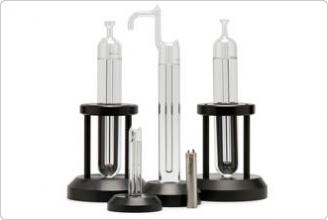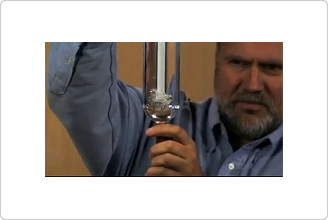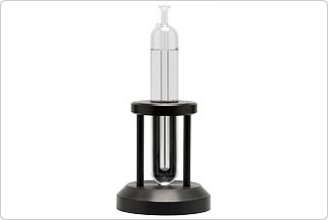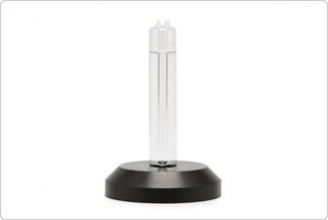- Other Fluke companies:
- Fluke
- Fluke Biomedical
- Fluke Networks
- Fluke Process Instruments
Must-have, primary temperature standards
- Easy-to-use, inexpensive standard with uncertainty better than ± 0.0001 °C
- Four sizes and two shells (glass and quartz) to choose from
- Isotopic composition of Vienna Standard Mean Ocean Water
The triple point of water (TPW) is not only the most accurate and fundamental temperature standard available, it’s also one of the least expensive and simplest to use.
Water cells are essential!
Triple point of water cells fill four critical purposes. First, they provide the most reliable way to identify unacceptable thermometer drift between calibrations—including immediately after a calibration if the thermometer has been shipped. Interim checks are critical for maintaining confidence in thermometer readings between calibrations. Second, they provide a critical calibration point with unequaled uncertainties.
Third, for users who characterize probes using ratios (that is, they use the ratios of the resistances at various ITS-90 fixed points to the resistance of the thermometer at the triple point of water, indicated by “W"), interim checks at the triple point of water allow for quick and easy updates to the characterizations of critical thermometer standards, which can be used to extend calibration intervals.
And lastly, the triple point of water is where the practical temperature scale (ITS-90) and the thermodynamic temperature scale meet, since the triple point of water is assigned the value 273.16 K (0.01 °C) by the ITS-90 and the Kelvin is defined as 1/273.16 of the thermodynamic temperature of the triple point of water.
Good triple point of water cells contain only pure water and pure water vapor. (There is almost no residual air left in them.) When a portion of the water is frozen correctly and water coexists within the cell in its three phases, the “triple point of water" is realized. Fluke Calibration water cells achieve this temperature with expanded uncertainties of less than 0.0001 °C and reproducibilities within 0.00002 °C.
In simple terms, water cells are made from just glass and water, but there’s much more to it than that!
For starters, that’s not just any water in there.
Heavy water
Fluke Calibration cells contain carefully and repetitively distilled ocean water and are meticulously evacuated and sealed to maintain an isotopic composition nearly identical to the international standard, “Vienna Standard Mean Ocean Water," or “VSMOW."
The oxygen atoms found in most water are predominantly comprised of eight protons and eight neutrons (16O). Some oxygen atoms, however, have an extra neutron (17O) or two (18O). Similarly, the hydrogen atoms in water normally contain only a single proton (1H), but sometimes contain a neutron also (2H), resulting in “heavy" water. These isotopes coexist in varying proportions in ocean water, polar water, and continental water, with ocean water being the heaviest.
The ITS-90 recommends that water cells be made from water with “substantially the isotopic composition of ocean water." Research has shown that TPW errors associated with isotopic composition can be as large as 0.00025 °C. The uncertainty contribution from VSMOW errors in a Fluke Calibration cell is less than ± 0.000007 °C. That’s seven micro-Kelvin!
Fluke offers two options for verifying the isotopic composition of any purchased water cell, both at nominal costs. We can submit to a testing laboratory a sample of water taken from your own cell (after it was completely manufactured, so you get a valid comparison) and give you the test report. Or we can send that water sample to you in a sealed ampoule for you to conduct your own tests. We can even provide multiple samples from the same cell (virtually as many as you’d like) so you can check for changes over time.
Impurities
Further, the potential for errors due to water impurity is even greater than the errors from isotopic composition. Fluke Calibration cells undergo multiple distillation processes and utilize special techniques to retain water purity. Among other things, our primary standards scientists are able to connect quartz cells directly to the glass distillation system without using coupling hardware that may invite contamination.
Glass vs. quartz
Most Fluke water cells may either be purchased with borosilicate glass or with fused silica (“quartz") housings. What’s the difference? Glass is less expensive than quartz, but it’s also more porous, allowing impurities to pass through it over time. Research indicates that cells made from glass typically drift about 0.00006 °C per year.
Many sizes
Fluke cells come in four general sizes. Models 5901A, 5901C, and 5901D each come in either quartz or glass shells and include 265 mm of thermometer immersion depth. The primary difference between these models (other than the arm on the 5901A) is the inside diameter of the probe well. (See the cell dimensions on the specifications tab and note that the inside diameter of the 5901C cells varies with the shell material). A variety of baths are available, which can maintain the triple point within these cells for many weeks. Accredited (NVLAP) test certificates are available with any cell under our model 1904-TPW.
5901A cells include an arm that can be used as a handle, a hook, or a McLeod gauge to demonstrate how much residual air is trapped in the cell. Carefully developed manufacturing processes at Fluke keep the air bubble in a quartz cell as small as the air bubble in glass cells. A fourth size, the 5901B cell, comes in a glass version and is significantly smaller than the other cells. It is designed for use in our 9210 Maintenance Apparatus, which automates the realization and maintenance of the TPW. The 9210-5901B combination is perfect for both calibrating thermometers and providing periodic checks of sensor drift.
Accessories
F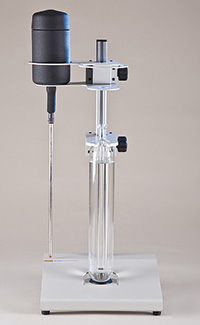 or simplest realization of the TPW in our larger cells, the 2031A “Quick Stick" Immersion Freezer uses dry ice and alcohol to facilitate rapid formation of an ice mantle within the cell without requiring constant intervention while the mantle forms.
or simplest realization of the TPW in our larger cells, the 2031A “Quick Stick" Immersion Freezer uses dry ice and alcohol to facilitate rapid formation of an ice mantle within the cell without requiring constant intervention while the mantle forms.
Insurance is also available for each water cell purchased from Fluke. Water cells are not difficult to handle nor is the TPW difficult to realize, but they are delicate and accidents do happen. For a nominal fee, we’ll insure your cell in one-year increments. If something goes wrong, just let us know and we’ll replace your cell. No questions asked.
There is no tool available to temperature metrologists more valuable than a reliable triple point of water cell. Fluke Calibration cells use the right water, right enclosures, and right manufacturing methods to ensure you get the best cells available in the world.
Specifications |
5901A-G | 5901A-Q | 5901C-G | 5901C-Q | 5901D-G | 5901D-Q | 5901B-G |
| Expanded Uncertainty (k=2) |
< 0.0001 °C | < 0.0002 °C | |||||
| Reproducibility | 0.00002 °C | 0.00005 °C | |||||
| Dimensions | 50 mm OD 12 mm ID 450 mm long |
60 mm OD 13.6 mm ID 420 mm long |
60 mm OD 14.4 mm ID 420 mm long |
60 mm OD 12 mm ID 420 mm long |
30 mm OD 8 mm ID 180 mm long |
||
| Immersion Depth (water surface to well bottom) |
265 mm | 118 mm | |||||
| Material | Borosilicate Glass |
Fused Silica (Quartz) |
Borosilicate Glass |
Fused Silica (Quartz) |
Borosilicate Glass |
Fused Silica (Quartz) |
Borosilicate Glass |
| Water Source | Ocean | ||||||
| dDVSMOW | ± 10 ‰ (± 1 %) | ± 20 ‰ | |||||
| d18OVSMOW | ± 1.5 ‰ (± 0.15 %) | ± 3 ‰ | |||||
| Effect of deviation from VSMOW |
± 7 µK | ± 14 µK | |||||
| Model Name | Description |
|---|---|
| 5901A-G |
TPW Cell, 12 mm ID with handle, glass shell |
| 5901A-Q |
TPW Cell, 12 mm ID with handle, quartz shell |
| 5901C-G |
TPW Cell, 13.6 mm ID, glass shell |
| 5901C-Q |
TPW Cell, 14.4 mm ID, quartz shell |
| 5901D-G |
TPW Cell, 12 mm ID, glass shell |
| 5901D-Q |
TPW Cell, 12 mm ID, quartz shell |
| 5901B-G |
TPW Cell, mini, glass shell |
Accessories common to all models:
| Accessory | Description |
|---|---|
| 3901-11 |
TPW Bushing, 5901/5901A to 7.5 mm |
| 3901-12 |
TPW Bushing, 5901/5901A to 5.56 mm (7/32 in) |
| 3901-13 |
TPW Bushing, 5901/5901A to 6.35 mm (1/4 in) |
| 3901-21 |
TPW Bushing, 5901C to 7.5 mm |
| 3901-22 |
TPW Bushing, 5901C to 5.56 mm (7/32 in) |
| 3901-23 |
TPW Bushing, 5901C to 6.35 mm (1/4 in) |
| 2031A |
"Quick Stick" Immersion Freezer |
| 1904-Tpw |
Accredited Cell Intercomparison, Triple Point of Water |
| 5901-ITST |
Isotopic Composition Analysis, TPW Cell |
| 5901-SMPL |
Water Sample, TPW Cell (comes in a sealed glass ampoule) |
| Priority Gold Instrument CarePlan |
Fluke Calibration Priority Gold Instrument CarePlans are available for most calibration products. Please contact your local Fluke Calibration sales representative for details or to request a quote. You may also call the Customer Care Center at 800-882-6153 or send email to premiumcare@fluke.com. |
| Silver CarePlan |
Fluke Calibration Silver CarePlans are available for most calibration products. Please contact your local Fluke Calibration sales representative for details or to request a quote. You may also call the Customer Care Center at 877-355-3225 or send email to careplans@flukecal.com. |
| Application Notes |
|---|
| General Calibration / Metrology Topics |
|---|
| Data Sheets |
|---|
| Video |
|---|
| Triple Point of Water Realization Technique | Fluke Video |
| On-Demand Webinars |
|---|
| Kelvin Redefinition and What It Means for You |
| Overcoming Drift: Tips to Maintaining Your PRTs |
- Home
- Products
- New Products
- Electrical Calibration
- RF Calibration
- Data Acquisition and Test Equipment
- Temperature Calibration
- Humidity Calibration
- Pressure Calibration
- Flow Calibration
- Process Calibration Tools
- Calibration Software
- Service and Support
- All Calibration Instruments
- Handheld Test Tools
- Purchase Info
- News
- Training and Events
- Literature and Education
- Service and Support
- About Us
Sidebar Request a Quote
Request a quote


